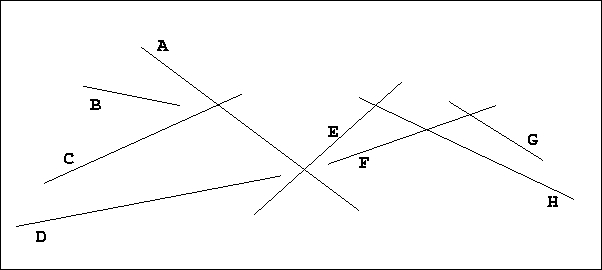Type A patients can only receive type A or O; type B patients can receive only type B or O; type O patients can receive only type O; and type AB patients can receive any of the four types.Blood type A B O AB Supply 46 34 45 45 Demand 39 38 42 50
-
Give a max flow formulation that determines a distribution that
satisfies the demands of a maximum number of patients. Draw the directed
graph and put the edge capacity above each edge. Your network should have 10
vertices: a source (named 0), a supply node for each of the four blood types
(named 1 to 4, in the order given above), a demand node for each blood type (named 5 to 8), and a sink
(named 9).
-
Solve the maximum flow problem using the Ford-Fulkerson
augmenting path algorithm. Do the first augmentation on the path
0-2-8-9. (This will force you to use a backwards edge at some point
during the rest of the algorithm.) Afterwards, always choose the
augmenting path with the fewest number of arcs, breaking ties in favor of
the lexicographically smallest path (e.g., choose 0-2-7-9 over 0-4-6-9).
List each of the augmenting paths. Also, write and circle the final
flow values on each arc in the network drawn in the last part.

In particular, number the points in the order in which they would be processed. Then indicate the sequence of values of the stack following each iteration of the main outer loop of the algorithm. (Use the stack-based algorithm given in class, or see Section 33.3 of CLRS.)

In particular, use vertical lines to indicate where each "interesting event" occurs. At each of these, indicate the "active" line segments and their order. Also indicate which pairs of lines are tested for intersection at each of these events, and which intersections are discovered.
Formulate (but do not solve) a linear program to find the most economical menu.Serving Energy Protein Calcium Cost per serving Max servings Food Size (kcal) (g) (mg) (cents) per day --------------------------------------------------------------------------------------- Oatmeal 28g 110 4 2 3 4 Chicken 100g 205 32 12 24 3 Eggs 2 large 160 13 54 13 2 Whole milk 237cc 160 8 285 9 8 Cherry pie 170g 420 4 22 20 2 Pork with beans 260g 260 14 80 19 2
Consider the elimination network constructed to test the elimination of a
particular team x. Let C = (S, T) be any min-cut (i.e., minimum
capacity s-t cut) of this network. Let R be the set of team nodes on
the source side of the cut (i.e., in S). Let n be the number of teams
in R. Let m = w[x] + r[x] be the most games that team
x can win.
- Let L be the sum of all edges leaving R. Give an expression for
L
in terms of n and m.
- Let I be the sum of all capacities of edges leaving s and entering
any game node or team node involving only teams in R (that is, either a
team node i, where i is in R, or a game node
i-j where both i and j are
in R). Explain why, regardless of the outcomes of all
future games, the total number of games won by all the teams in R
will total at least I.
- Let C' = (S', T') be a cut that separates
s from the rest of the
network (that is, S' = {s}). Show that if I <=
L then the capacity
of C' is at most the capacity of C, and therefore that C' is also a
min-cut.
- Suppose that the value of the max-flow is strictly less than the
total capacity of all edges leaving s. Show that C' is not a
min-cut in this case, and therefore that I > L.
- Conclude that if the value of the max-flow is strictly less than the total capacity of all edges leaving s then the average number of games won by teams in R is strictly greater than m, the best possible number of games winnable by x.